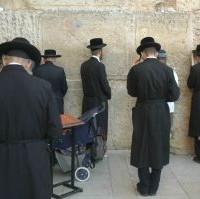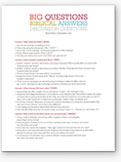
In the next part of Jesus’ revelations regarding the future, He turns His attention to Jerusalem in 70 AD. Matthew 24:15-20 finally answers the apostles’ initial inquiry: when will the destruction of the temple in Jerusalem take place?
“So when you see standing in the holy place ‘the abomination that causes desolation,’ spoken of through the prophet Daniel—let the reader understand—then let those who are in Judea flee to the mountains. Let no one on the roof of his house go down to take anything out of the house. Let no one in the field go back to get his cloak. How dreadful it will be in those days for pregnant women and nursing mothers! Pray that your flight will not take place in winter or on the Sabbath.”
Notice how geographically and culturally specific Jesus is. People in Judea should run when they see something awful in the holy place of the temple. Therefore, this section is for the generation of Jews in the first century.
Jesus prophesied that the sign to observe was “the abomination that causes desolation.” In other words, a detestable, or offensive, thing that destroys would stand in the Temple. When that occurred, people should run for their lives, not bothering to pack a bag or retrieve items left behind. Obviously, pregnant women would have difficulty fleeing, as would parents of small children. Inclement weather would make their flight, or escape, challenging. Another challenge would be escaping on the Sabbath. Faithful Jews believed that they could only travel a prescribed distance on the Sabbath of about three-quarters of a mile, based on rabbinical interpretations of Exodus 16:29, Numbers 35:5, and Joshua 3:4. Whatever the circumstance of these first century believers, Jesus was clear: get out of Jerusalem.
Christ referenced the prophet Daniel when He made this announcement about the “abomination that causes desolation.” In Daniel 11:31, it says, “His armed forces will rise up to desecrate the temple fortress and will abolish the daily sacrifice. Then they will set up the abomination that causes desolation.” He was prophesying about Antiochus Epiphanes, a Greek ruler in power from 175-164 BC. Josephus, the first century Jewish historian, records that in 168 BC, Antiochus Epiphanes did indeed plunder the temple. In blasphemy, he built an altar to Zeus inside. Furthermore, he sacrificed pigs, continuing the desecration. Josephus says,
He also spoiled the temple, and put a stop to the constant practice of offering a daily sacrifice of expiation for three years and six months…Now Antiochus was not satisfied either with his unexpected taking the city, or with its pillage, or with the great slaughter he had made there; but being overcome with his violent passions, and remembering what he had suffered during the siege, he compelled the Jews to dissolve the laws of their country, and to keep their infants uncircumcised, and to sacrifice swine’s flesh upon the altar.
In approximately 536 BC, Daniel said this “abomination that causes desolation”, a detestable thing that destroys, would invade Jerusalem’s Temple. In 168 BC this prophecy came true. In approximately 30 AD, Jesus declared that history would repeat itself. In 70 AD, His prophecy came true as well.
Titus Vespasian, who would eventually rule Rome from 79-81 AD, surrounded and attacked the city of Jerusalem. He plundered and burned the temple, entering the Holy of Holies before it was engulfed in flames. Josephus recorded the details:
At which time one of the soldiers…set fire to a golden window, through which there was a passage to the rooms that were round about the holy house, on the north side of it…And now a certain person came running to Titus, and told him of this fire, as he was resting himself in his tent after the last battle; whereupon he rose up in great haste, and, as he was, ran to the holy house, in order to have a stop put to the fire…And now, since Caesar was no way able to restrain the enthusiastic fury of the soldiers, and the fire proceeded on more and more, he went into the holy place of the temple, with his commanders, and saw it.
The greatest fear of the Jews, that the temple would become desolate again and the people taken into captivity, was exactly what Jesus was foretelling. Yet He was also telling His apostles when to escape. Luke 21:20 records Jesus saying, “When you see Jerusalem being surrounded by armies, you will know that its desolation is near.” Thankfully, later disciples took Jesus’ prophecy to heart. “The apostolic church remembered Jesus’ words. When it became clear that Rome was going to use great force to put down the ever-growing Jewish rebellion in the latter part of A.D. 66-67, those Christians remaining in Jerusalem did indeed relocate to the hill country to the northeast in the Transjordan.”
How terrible was the Roman attack on Jerusalem that these Christians avoided? Besides the massive casualties, Josephus said 1.1 million people were killed in the overall campaign. Another 97,000 were hauled away as slaves. Eusebius, a 3rd century church historian, records that the Christians escaped Jerusalem, going specifically to the city of Pella as the Roman armies approached. These early Christians were an example of faithful obedience to the words of Christ. And faithfulness will be needed again as events unfold before Christ’s Second Coming.
Learn how to defend your Christian Faith

Big Questions Biblical Answers Supplemental Materials
by Brad Alles
- November 2024
- August 2024
- July 2024
- June 2024
- September 2022
- August 2022
- July 2022
- June 2022
- May 2022
- April 2022
- March 2022
- February 2022
- January 2022
- December 2021
- November 2021
- October 2021
- September 2021
- August 2021
- July 2021
- June 2021
- May 2021
- April 2021
- March 2021
- February 2021
- January 2021
- December 2020
- November 2020
- October 2020
- September 2020
- August 2020
- July 2020
- June 2020
- May 2020
- April 2020
- March 2020
- February 2020
- January 2020
- December 2019
- November 2019
- October 2019
- September 2019
- August 2019
- July 2019
- June 2019
- May 2019
- April 2019
- March 2019
- February 2019
- January 2019
- December 2018
- November 2018
- October 2018
- September 2018
- August 2018
- July 2018
- June 2018
- May 2018
- April 2018
- March 2018
- February 2018
- January 2018
- December 2017
- November 2017
- October 2017
- September 2017
- August 2017
- July 2017
- June 2017
- May 2017
- April 2017
- March 2017
- February 2017
- January 2017
- December 2016
- November 2016
- October 2016
- September 2016
- August 2016
- July 2016
- June 2016
- May 2016
- April 2016
- March 2016
- February 2016
- January 2016
- December 2015
- November 2015
- October 2015
- September 2015
- August 2015
- July 2015
- May 2015
- April 2015
- March 2015
- February 2015
- January 2015
- December 2014
- November 2014
- October 2014
- September 2014
- August 2014
- July 2014
- June 2014
- May 2014
- April 2014
- March 2014
- February 2014
- January 2014
- December 2013
- November 2013
- October 2013
- September 2013
- August 2013
- July 2013
- June 2013
- May 2013
- April 2013
- March 2013
- February 2013
- January 2013
- December 2012
- November 2012
- October 2012
- September 2012
- August 2012
- July 2012
- June 2012
- May 2012
- April 2012
- March 2012
- February 2012
- January 2012












Comments are closed.